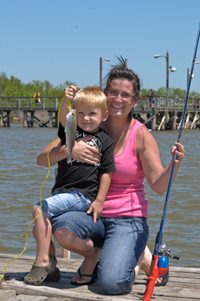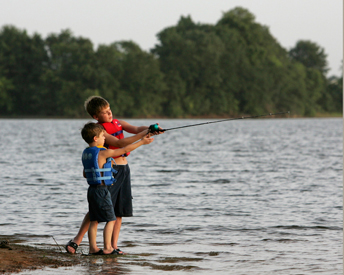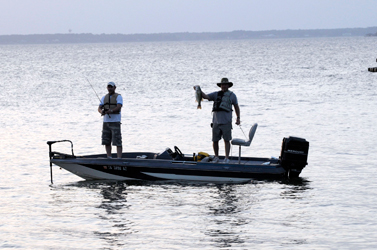Activity / How-To
FISHING HOT SPOTS IN STATE PARKS
Its fun, its free, and you dont need a fishing license.
By: Larry D. Hodge
If Texas state parks dont rank high on your list of favorite fishing spots, think again.
No matter what species of freshwater fish you seek, state parks offer some of the best fishing in Texas. And you dont even need a license to fish within the boundaries of a state park. Park admission fees do apply, however.
In addition, if you are a novice angler or want to teach your kids how to fish, a number of parks around the state hold special family-oriented Go Fish! Learn-to-Fish events. Although there is an emphasis on teaching kids, everyone can learn basic fishing skills through fun hands-on activities. Then, everyone can try their luck while experts are on hand to help reel in the catch. You can bring your own gear or borrow gear at the event. And, watch for some special events such as basic fly fishing classes and fishing classes and fishing derbies. Because these events are co-sponsored by Walmart and local businesses, prizes of fishing gear add to the fun.
The next best thing to a good fishing hole is inside information on how to fish it. TPWD park managers and freshwater fisheries biologists gave me their top picks for state park fishing and shared some tips for success. Ill profile some hotspots and give brief information on others. For more detailed information, including fishing tips, visit Recreational Fishing on the TPWD web site.
Dallas/Fort Worth Metro Area
Near Pilot Point. (940) 686-2148, (940) 637-2294.
The 30,000-acre Lake Ray Roberts is a big state park with three units Isle du Bois, Johnson Branch and Jordan and six satellite units around the lake. The Jordan Unit offers guest rooms and a restaurant.
Largemouth bass fishing is good all year, says TPWD Inland Fisheries biologist Bruce Hysmith. There are about 40 sunken brush piles which are shown on lake maps. Texas-rigged plastic worms are good bait in the summer, as are topwater baits early and late in the day. In fall and winter, try slow-fishing crankbaits or heavy jigs. Fish the bottoms of standing timber, even in deep water. The fishing pier on the Isle du Bois unit is good for largemouth bass as well as for crappie, white bass and sunfish. The Johnson Branch unit has great shoreline access.
Ray Roberts has good white bass fishing in spring and summer; look for schools of sandies surfacing near the dam and drop heavy jigs or slabs into the schools. Channel catfish are plentiful in the lake. They will take live shad, cut shad, blood bait or shrimp drifted along the bottom in 12 to 15 feet of water.
Near Denison. (903) 465-1956.
Eisenhower State Park is only 423 acres, but it offers some of the most scenic campsites in the state. The park is perched on the shore of 89,000-acre Lake Texoma. The lake boasts excellent populations of striped bass, blue catfish and smallmouth, spotted and largemouth bass, says Bruce Hysmith. The state record blue catfish 121.5 pounds was caught from the lake in 2004. Striped bass fishing peaks in May and June and again from October through December.
Night fishing off the ADA-accessible, lighted fishing pier for panfish, bass and catfish is good, says Park Superintendent Paul Kisel. Hysmith rates striped bass fishing off the lighted pier as awesome from fall to spring and recommends the point below Armadillo Hill for striped bass when northwest winds blow.
Near Cooper. (903) 945-5256.
Cooper Lake is a 19,000-acre impoundment with excellent fishing for largemouth bass, catfish, white and hybrid striped bass and crappie. Standing timber, brush piles, islands and fencerows provide structure for largemouth bass and crappie. White bass school in summer around main-lake points and humps. Fish for crappie within the park along the wall at the Heron Harbor day use area in the South Sulphur Unit.
Hybrid striped bass fishing peaks in the dog days of summer, and action often does not begin until mid-afternoon. Youll find the stripers chasing shad over humps in the main lake in 20 to 30 feet of water. Use your electronics to find them, then drop slabs or other minnow-imitating lures into the pack and hang on.
Houston Metro Area
Near Needville. (979) 553-5102.
We have three small lakes and a medium-sized creek that provide good fishing for largemouth bass, crappie, channel and blue catfish and sunfish, says park manager Steve Killian. Fishing piers are located at 40-acre, Elm and Hale lakes. Fishing from the piers is a good idea: Alligators are abundant in the park.
Austin Metro Area
Near Burnet. (512) 793-2223.
Inks Lake has very little fishing pressure, and the constant lake level ensures that fishing is always available, says former park manager Rick Meyers. Fishing is great, especially for striped bass, white bass, sunfish and catfish, although crappie and black bass are abundant. Almost anyone with a pole and bait can catch a mess of fish throughout the year.
Rangers offer free fishing programs for families every Saturday from spring through fall, and loaner tackle is available. The park has two lighted fishing piers, but bank fishing is good anywhere in the park. The park store rents canoes and kayaks and sells tackle and bait.
Fly fishing for sunfish commonly produces sunfish the size of your hand, Meyers says. White bass are excellent during the spring and fall and will hit just about anything that shines.
Perhaps the best thing about Inks Lake is what surrounds the water: Some of the prettiest scenery in the entire Hill Country. Live oaks cover pink granite hills, and wildlife is abundant.
San Antonio Metro Area
Near Three Rivers. (361) 786-3538 or (361) 786-3868.
Three words: Largemouth bass, hydrilla. Find the grass and you will find the bass. The morning top-water bite is good around hydrilla until the sun gets high, says park manager Rhett Kruse. Then switch to Texas-rigged soft plastic floating worms the best color is watermelon with red flake. Small white spinner baits will also work during mid-morning.
Many catfish anglers on Choke Canyon go after blue and channel cats in shallow water among flooded vegetation using cheese baits. Local guides target catfish under cormorant roosts.
Some of the better catfishing is in 20 to 40 feet of water, Kruse says. The Calliham Unit has a jetty near the boat ramp that gives access to deeper water. Theres also a 75-acre lake within the park that is for bank fishing only; its stocked with catfish, bass and sunfish.
West Texas/Panhandle Area

Near Wichita Falls. (940) 528-2211.
Lake Arrowhead is known primarily for its superb spring and fall crappie fishing, but the lake produces very nice limits of white bass, black bass and catfish year-around, says assistant park manager James Harden. People flock to the parks fishing pier and floating docks during the spring and fall to fish for crappie. We also have tackle for loan.
For crappie, Inland Fisheries biologist Mark Howell suggests using a 1/16th-ounce chartreuse jig with in-line spinners off any of the rip-rap areas. Try drift fishing for blue catfish with shrimp or use punch bait near standing timber where cormorants roost, he advises. White bass school near flats early and late in the day and bite silver spoons or shad-imitating crankbaits like they do everywhere else.
Near Tuscola. (325) 572-3204.
Buffalo Wallow is only a 1-acre pond, but it has been developed especially with children in mind. Weve stocked it with sunfish, bass and channel catfish, says ranger Paul Seals, and all a kid needs is a cane pole, a red-and-white bobber and a can of night crawlers to have a ball.
Near Brownwood. (325) 784-5223.
White bass and hybrid striped bass are the big deal from early May through October. Slabbing along creek and river channels produces lots of fish. When sandies school in the main lake, follow the birds to get in on the action. When days are hot, night fish for white bass around lighted boat docks.
East Texas

Near Tatum. (903) 836-4336.
The catfishing at Martin Creek Lake is exceptional, says Inland Fisheries biologist Todd Driscoll. Both blue and channel catfish have been stocked into the lake. The preferred method of catching them is with stink bait over holes baited with soured grain.
The lake also has a healthy population of sunfish and crappie. Catch crappie with jigs and minnows fished over brush piles and around bends in creeks. Sunfish bite aggressively during the late spring and early summer spawn. Small jigs or spinners, earthworms and crickets will all produce lots of action.
Near Pittsburg. (903) 572-5531.
Park ranger Paul Harris says the lighted fishing pier at the park offers anyone an excellent opportunity to catch fish. The lake record largemouth bass 14 pounds, 5 ounces was caught from the pier by a crappie angler, he says. Crappie, catfish and sunfish can also be caught from the pier. White bass are abundant.

Near Livingston. (936) 365-2201.
Lake Livingston was lowered several feet due to damage to the dam during Hurricane Rita, and that may help the catfish and white bass fishing, which were already excellent, says Inland Fisheries biologist Mark Webb. The lower water level may cause a more concentrated white bass run, and the blue cats may be even easier to locate, he says. TPWD fisheries biologists have noted large schools of blue catfish suspended in the lake.
South Texas
Near Falcon Heights. (956) 848-5327.
Falcon International Reservoir has bounced back from a decade of low water levels and is regaining its reputation as one of the hottest largemouth bass lakes in the nation. Flooded vegetation and submerged buildings hold lots of big bass, but summer temperatures of 100 degrees or more can be brutal. Dont overlook the channel catfish they bite any time of year. Because of its southern location, Falcon offers winter fishing in spring-like temperatures while the rest of the state shivers.
Gulf Coast Area
Lake Corpus Christi State Park
Near Mathis. (361) 547-2635.
Many anglers on their way to fish the bays around Corpus Christi overlook the fishing in Lake Corpus Christi. Catfishing is rated excellent; fishing for largemouth bass, crappie, white bass and sunfish is good.
Channel, blue and flathead catfish are all present. Try for blue and channel cats with cheese bait in flooded brush in shallow water. Big blues and flatheads prefer live bait and can be caught on trotlines or jug lines in the main Nueces River channel.
Fish for crappie off the parks lighted fishing pier. Small jigs may catch more fish than minnows under the lights. White bass running in the river also like a variety of small minnow-imitating baits as well as the real thing.
Near Edna. (361) 782-5718.
Like Lake Corpus Christi, Lake Texana is often overshadowed by the nearby coast. However, blue and channel catfish are abundant, and crappie fishing is excellent. Dabble small white, pink or chartreuse crappie jigs around the edges of floating vegetation or submerged brush.
White bass gang up in the Navidad River and Sandy Creek channels prior to the December-January spawning run. Try for hybrid striped bass near the dam with live shad or minnows or shad-imitating rattling baits.
Remember that boat ramps are sometimes inaccessible if water levels are low, so call ahead to check. And finally, park personnel are there to help you have a safe, enjoyable outdoor experience and will be happy to advise you on where and how to fish.
———This article appeared in the TPWD Magazine June 2006 Skillbuilder. If you’d like to read more articles like this or subscribe to the magazine, visit www.tpwmagazine.com.
 Texas Parks and Wildlife Department, 4200 Smith School Road, Austin, TX 78744
Texas Parks and Wildlife Department, 4200 Smith School Road, Austin, TX 78744


